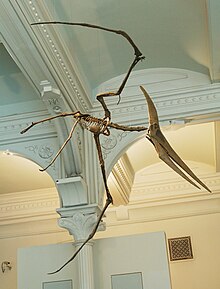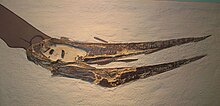
Description[edit]
Pteranodon pieces are extremely well represented in the fossil record, allowing for detailed descriptions of their anatomy and analysis of their life history. Over 1,000 specimens have been identified, though less than half are complete enough to give researchers good information on the anatomy of the animal. Still, this is more fossil material than is known for any other pterosaur, and it includes both male and female specimens of various age groups and, possibly, species.[2]
Size[edit]
Adult Pteranodon specimens from the two major species can be divided into two distinct size classes. The smaller class of specimens have small, rounded head crests and very wide pelvic canals, even wider than those of the much larger size class. The size of the pelvic canal probably allowed the laying of eggs, indicating that these smaller adults are females. The larger size class, representing male individuals, have narrow hips and very large crests, which were probably for display.
Adult male Pteranodon were among the largest pterosaurs, and were the largest flying animals known until the late 20th century, when the giant azhdarchid pterosaurs were discovered.[2]The wingspan of an average adult male Pteranodon was 5.6 metres (18 ft). Adult females were much smaller, averaging 3.8 metres (12 ft) in wingspan. The largest from the Niobrara Formation measured 6.25 metres (20.5 ft) from wingtip to wingtip. An even larger specimen is known from the Pierre Shale Formation, with a wingspan of 7.25 metres (23.8 ft), though this specimen may belong to the distinct genus and species Geosternbergia maysei.[2] While most specimens are found crushed, enough fossils exist to put together a detailed description of the animal.
Methods used to estimate the mass of large male Pteranodon specimens (those with wingspans of about 7 meters) have been notoriously unreliable, producing a wide range of estimates from as low as 20 kilograms (44 lb) and as high as 93 kilograms (205 lb). In a review of pterosaur size estimates published in 2010, researchers Mark Witton and Mike Habib demonstrated that the latter, largest estimates are almost certainly incorrect given the total volume of a Pteranodon body, and could only be correct if the animal "was principally comprised of aluminium."[3] Witton and Habib considered the methods used by researchers who obtained smaller mass estimates equally flawed. Most have been produced by scaling modern animals such as bats and birds up to Pteranodon size, despite the fact that pterosaurs have vastly different body proportions and soft tissue anatomy from any living animal.[3]
Skull and beak[edit]
Unlike earlier pterosaurs such as Rhamphorhynchus and Pterodactylus, Pteranodon had toothless beaks, similar to those of birds. Pteranodon beaks were made of solid, bony margins that projected from the base of the jaws. The beaks were long, slender, and ended in thin, sharp points. The upper jaw was longer than the lower jaw. The upper jaw was curved upward; while this normally has been attributed only to the upward-curving beak, one specimen (UALVP 24238) has a curvature corresponding with the beak widening towards the tip. While the tip of the beak is not known in this specimen, the level of curvature suggests it would have been extremely long. The unique form of the beak in this specimen led Alexander Kellner to assign it to a distinct genus, Dawndraco, in 2010.[4]
The most distinctive characteristic of Pteranodon is its cranial crest. These crests consisted of skull bones (frontals) projecting upward and backward from the skull. The size and shape of these crests varied due to a number of factors, including age, sex, and species. Male Pteranodon sternbergi, the older species of the two described to date (and sometimes placed in the distinct genus Geosternbergia), had a more vertical crest with a broad forward projection, while their descendants, Pteranodon longiceps, evolved a narrower, more backward-projecting crest.[1] Females of both species were smaller and bore small, rounded crests.[5] The crests were probably mainly display structures, though they may have had other functions as well.[6]
Skeleton[edit]
Other distinguishing characteristics that set Pteranodon apart from other pterosaurs include narrow neural spines on the vertebrae, plate-like bony ligaments strengthening the vertebrae above the hip, and a relatively short tail in which the last few vertebrae are fused into a long rod.[7] The entire length of the tail was about 3.5% as long as the wingspan, or up to 25 centimetres (9.8 in) in the largest males.[7]


No comments:
Post a Comment